Are you a Quiet Speculation member?
If not, now is a perfect time to join up! Our powerful tools, breaking-news analysis, and exclusive Discord channel will make sure you stay up to date and ahead of the curve.
Battle for Zendikar promises to bring a lot of new toys to Modern. RG Tron stands to gain new colorless targets for Ancient Stirrings while Through the Breach decks could get some new monsters to cheat into play. Burn players might benefit from a Goblin Guide reprint (or maybe not with Goblin Piledriver in Standard…). Modern brewers are probably looking forward to other newcomers, including trap cards, Vampires, and (of course) the Rosewater-confirmed return of Allies . Can’t wait until September for the new Allies? Luckily, Modern already has Ally decks for you competitive tribal players.

In today’s Deck of the Week, we are going to look at an Allies/Collected Company blend from a recent PPTQ in Italy. As with last week’s spotlight on Soulflayer Aggro, we’ll analyze the deck itself, look at its current and historical context, and suggest some room for improvement. Allies have always been one of my favorite tribes, and I’m excited to see them get even a little face time in Modern. Let’s see what this tribe can do with some more tuning!
[wp_ad_camp_1]
The List and Strategy
Like Goblins, Humans, and other fringe tribal decks, Allies has a limited history in Modern. This mostly takes the form of Daily appearances with the occasional paper finish. Authors sometimes tackle the tribe, as Frank Lepore did in a tech piece back in March 2015. Showing just how diverse Modern is (not to mention how powerful some of its new cards are), Daniel Mulato took an Allies deck to a Top 8 finish at a recent Italian PPTQ. Mulato got fourth at the event in Montecatini Terme on 7/26, playing in a Top 8 against usual suspects like Jund, Merfolk, Grixis Control, and Burn. Here is his semi-finalist list:
Company Allies, by Daniel Mulato (PPTQ Montecatini Terme July 2015, 4th Place)
As if Mulato's T4 win wasn't cool enough on its own, he came back a week later and snagged T8 at another PPTQ! His only changes were -1 Harabaz Druid and +1 Adaptive Automaton in the maindeck and -1 Suppression Field and +1 Rending Volley in the board.
Collected Company putting in more Modern work! Company has done wonders for the format, enabling at least three top-tier archetypes (Elves, Abzan Company, and Naya Zoo) and improving the odds of many other developing lists. Mulato’s Allies list is the newest tribal list to get a big boost from the card. The list has elements of both Merfolk and Naya Company, combining the synergy of the fish with the aggression and removal of Zoo. It even leverages Aether Vial, a card I explored in an earlier Deck of the Week on Modern Humans. Here are some of the key strengths and synergies in Mulato’s list, along with why these are relevant in the Modern metagame.
 Kabira Evangel is a total monster. Cast at sorcery-speed during your main phase, it effectively makes your entire squad unblockable. This alpha-strike potential is huge against the grindier decks in Modern, such as Jund, Abzan Company, and Grixis Control (just watch out for the Cryptic Command tapdown). Combined with Aether Vial, or a lucky Company flip, Evangel gets even crazier. He singlehandedly invalidates the format’s spot removal, protecting your key allies from Terminate, Lightning Bolt, Abrupt Decay, Path to Exile and any other spells thrown your way. He can also screw with combat math, shutting down an otherwise profitable attack. This is a unique effect no other tribe has access to, which makes Evangel a powerful tool in the Allies arsenal.
Kabira Evangel is a total monster. Cast at sorcery-speed during your main phase, it effectively makes your entire squad unblockable. This alpha-strike potential is huge against the grindier decks in Modern, such as Jund, Abzan Company, and Grixis Control (just watch out for the Cryptic Command tapdown). Combined with Aether Vial, or a lucky Company flip, Evangel gets even crazier. He singlehandedly invalidates the format’s spot removal, protecting your key allies from Terminate, Lightning Bolt, Abrupt Decay, Path to Exile and any other spells thrown your way. He can also screw with combat math, shutting down an otherwise profitable attack. This is a unique effect no other tribe has access to, which makes Evangel a powerful tool in the Allies arsenal.
 Ally triggers scale nicely with Collected Company. Have a Hada Freeblade in play and flip two Allies off of a Company? That’s two counters for the Freeblade and two triggers for your flipped allies as they “see each other” entering off Company. This adds up to a lot of damage in a big hurry. One issue with this strategy is that average flips, or flips on a wiped board, aren’t great. If you have no Allies in play, Company will (on average) get you a pair of 3/3s to hold the line. Compare to Zoo, which can easily flip a Smiter/Goyf combo. Then again, the better flips in Allies are much better than the flips in Naya. For instance, with a 2/3 Freeblade and 2/2 Blademaster on the board, a flipped Evangel and Battlesinger will smash across the board for an unblockable 15 damage (6/5 Freeblade, 6/4 Blademaster, 3/1 Battlesinger). Modern rewards explosive plays and Allies has serious smash potential. This also touches on the redundancy of Allies: they don’t need “Lords” to function the same way other tribes do. This makes them strong in spot removal packed metagames, or even against sweepers. Is an Ally getting bolted with Company or Vial ready? Send in reinforcements and pump your dude in response .
Ally triggers scale nicely with Collected Company. Have a Hada Freeblade in play and flip two Allies off of a Company? That’s two counters for the Freeblade and two triggers for your flipped allies as they “see each other” entering off Company. This adds up to a lot of damage in a big hurry. One issue with this strategy is that average flips, or flips on a wiped board, aren’t great. If you have no Allies in play, Company will (on average) get you a pair of 3/3s to hold the line. Compare to Zoo, which can easily flip a Smiter/Goyf combo. Then again, the better flips in Allies are much better than the flips in Naya. For instance, with a 2/3 Freeblade and 2/2 Blademaster on the board, a flipped Evangel and Battlesinger will smash across the board for an unblockable 15 damage (6/5 Freeblade, 6/4 Blademaster, 3/1 Battlesinger). Modern rewards explosive plays and Allies has serious smash potential. This also touches on the redundancy of Allies: they don’t need “Lords” to function the same way other tribes do. This makes them strong in spot removal packed metagames, or even against sweepers. Is an Ally getting bolted with Company or Vial ready? Send in reinforcements and pump your dude in response .
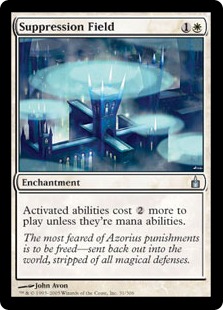 One of my favorite cards in Modern is Suppression Field. It screws over so many decks at such an early point in the game , and is something most players will never see coming. Unfortunately for Field fans like myself, not many decks can use it well. You need a white deck with minimal activated abilities, which realistically cuts out a slew of builds including Merfolk, Elves, Affinity, Burn, etc. Allies gets to run the full playset in the board. It’s rare we look to sideboards for a unique deck strength, but this is often a mistake. Some decks are uniquely suited to running powerful hate. Allies is a prime example of this, maintaining all of its core tribal synergies while still keeping an active Field. Vial is a casualty of this post-board gameplan, but that’s often the price you pay for the power of a turn two Field. Ondu Cleric is also in this category, powering out crazy amounts of life as early as turns 2-3. This buys you lots of time to handle decks like Burn and Affinity: Company and Vial can even combine with Cleric to dodge lifegain prevention effects like Skullcrack!
One of my favorite cards in Modern is Suppression Field. It screws over so many decks at such an early point in the game , and is something most players will never see coming. Unfortunately for Field fans like myself, not many decks can use it well. You need a white deck with minimal activated abilities, which realistically cuts out a slew of builds including Merfolk, Elves, Affinity, Burn, etc. Allies gets to run the full playset in the board. It’s rare we look to sideboards for a unique deck strength, but this is often a mistake. Some decks are uniquely suited to running powerful hate. Allies is a prime example of this, maintaining all of its core tribal synergies while still keeping an active Field. Vial is a casualty of this post-board gameplan, but that’s often the price you pay for the power of a turn two Field. Ondu Cleric is also in this category, powering out crazy amounts of life as early as turns 2-3. This buys you lots of time to handle decks like Burn and Affinity: Company and Vial can even combine with Cleric to dodge lifegain prevention effects like Skullcrack!
When I compare Allies to highter-tier tribal decks like Merfolk and Elves, the strengths that stand out to me are their explosiveness in the turn 3-4 range, their redundancy (everything is a mini-Lord), and their resilience to damage-based removal. With a Vial or Company at the ready, it’s really risky to aim burn spells (or even Anger of the Gods-style sweepers) at an Ally target. A vialed-in Evangel will save the day, and even a quick toughness pump from a newly entered creature can put the target out of range. With the metagame shifting to more battles against grindy decks like Jund and Grixis Control, this is a powerful asset for the tribe. Note this is also combined with the potential for huge Allies swings out of nowhere on turns 3-4. Even a turn five swing can quickly seal the game against even an entrenched opponent. Does this oversell Allies to some extent over Merfolk or Elves? Probably, but that’s part of the fun in working with new decks. You need to start somewhere, and Allies has some compelling foundations.
Allies in Context
Mulato may have been the most recent Allies player to put up a Modern win, but he’s by no means the first. MTGO player MadKat snagged three Daily finishes back in February, running a Hardened Scales-powered list in each of his 3-1 finishes. His sideboard had a lot of resemblances to 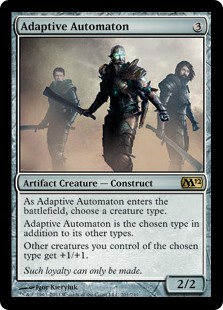 Mulato’s, with a combination of Ondu Cleric to blunt aggressive decks and Return to the Ranks to restock during removal-heavy games. The deck also sees some occasional play in the Japanese Modern scene, including a few finishes at the end of the December 2014 season and a recent one in early July. This recent list, piloted by Ishikawa Shou on July 4th, was an even more streamlined version of Mulato’s. Ishikawa brought a full playset of Adaptive Automaton to the deck, ditching the Druid accelerators and the four-mana Paladins. Although these are isolated instances of Allies succeeding in Modern (to some extent, you can find an isolated instance of almost any deck succeeding in Modern), they are heartening performances for Allies fans everywhere.
Mulato’s, with a combination of Ondu Cleric to blunt aggressive decks and Return to the Ranks to restock during removal-heavy games. The deck also sees some occasional play in the Japanese Modern scene, including a few finishes at the end of the December 2014 season and a recent one in early July. This recent list, piloted by Ishikawa Shou on July 4th, was an even more streamlined version of Mulato’s. Ishikawa brought a full playset of Adaptive Automaton to the deck, ditching the Druid accelerators and the four-mana Paladins. Although these are isolated instances of Allies succeeding in Modern (to some extent, you can find an isolated instance of almost any deck succeeding in Modern), they are heartening performances for Allies fans everywhere.
One of the hardest things to do as a brewer is evaluate the individual successes for rogue decks. This is particularly true of rogue tribal decks, which can often feel like worse versions of existing tribal decks (e.g. Merfolk and Elves) or even existing aggro decks (e.g. Affinity, Burn, and Naya Company). Modern 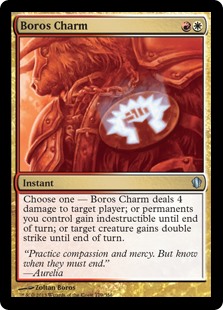 has a fairly high bar for deck viability, and most rogue builds fall solidly underneath that bar. Is there any metagame context that changes this outlook for Allies? As I mentioned earlier, one of these is the prevalence of fairer decks like Grixis Control and Jund, both of which are omnipresent in the metagame. These decks rely on spot removal and damage-based interaction, both of which Allies is uniquely suited to handling in its pump mechanisms, Evangel protection, Company recovery, and maindecked protection like Boros Charm. Another datapoint is the power of sideboard cards like Suppression Field and Ondu Cleric in this metagame. No other deck can run this kind of tribal-focused, bursty lifegain on top of a catchall like Field. Add to this the general power of white sideboard cards (Stony Silence, Rest in Peace, etc.), and Allies starts to look a lot more viable. The key in evaluating these kinds of decks isn’t to look at them in a vacuum. It’s to see what the strategy, or the tribe in this case, offers relative to the overall metagame. Allies is hardly a tier 2 deck, but it does have enough tools to address some important metagame realities.
has a fairly high bar for deck viability, and most rogue builds fall solidly underneath that bar. Is there any metagame context that changes this outlook for Allies? As I mentioned earlier, one of these is the prevalence of fairer decks like Grixis Control and Jund, both of which are omnipresent in the metagame. These decks rely on spot removal and damage-based interaction, both of which Allies is uniquely suited to handling in its pump mechanisms, Evangel protection, Company recovery, and maindecked protection like Boros Charm. Another datapoint is the power of sideboard cards like Suppression Field and Ondu Cleric in this metagame. No other deck can run this kind of tribal-focused, bursty lifegain on top of a catchall like Field. Add to this the general power of white sideboard cards (Stony Silence, Rest in Peace, etc.), and Allies starts to look a lot more viable. The key in evaluating these kinds of decks isn’t to look at them in a vacuum. It’s to see what the strategy, or the tribe in this case, offers relative to the overall metagame. Allies is hardly a tier 2 deck, but it does have enough tools to address some important metagame realities.
Improvements and Updates
When I’m working on a new deck, especially a new brew or rogue strategy, I want to do as much as possible to differentiate it from other strategies. It’s okay to borrow some concepts from successful lists. For instance, 3-4 Path to Exiles seems mandatory in almost any white-based aggro deck in Modern (Zoo, Hatebears, Death and Taxes, Bogles, etc.). Also, we don’t want to run fewer than 27-28 creatures if we are maximizing Collected Company. Howerver, just because we are taking these lessons to heart does not mean we should copy Hatebears or Elves. That’s a great way to become a worse version of those decks. So how do we emphasize unique Allies strengths while still tuning the list? Here are some big takeaways I have from our analysis so far:
- Jack up your Allies
Allies are some hardy guys, especially against the three-damage mainstays of Modern. It doesn’t take a lot of Ally triggers to put any of your team out of Bolt or Kolaghan's Command range, and we want to maximize this as much as possible. We also want to make our Allies too big to tangle with on the ground. Remember: we need to fight 4/5 Goyfs and Tasigurs, not to mention 5/5 Anglers. We aren’t doing this with a horde of Wild Nacatl wannabes, so we need to make sure our squad is as pumped as possible. This means maximizing creatures that make us big and putting in mechanisms to keep everything growing. Hello, Hardened Scales.
- Win out of nowhere
I’m comfortable playing a more traditional slugfest with Allies, but I also want to be able to close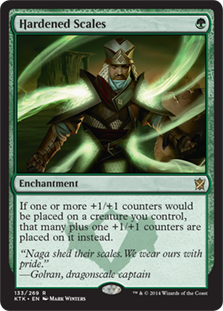 out a game on turn 4-5. Evangel is half of this puzzle, and Hardened Scales is the other half. As I’ve said in this article and in others, Modern rewards explosive gameplay. Scales is as explosive as you can get. Company flips become totally nuts with a Scales in play, and you can easily swing for at least 12 damage with just two creatures off a turn four Company. Following up from the point above, the enchantment also helps you win the ground war and the removal contest, which plays to another of our strength’s. I’m cutting the Vials for Scales because Kolaghan's Command is everywhere and Abrupt Decay has seen a steep decline with all the delve creatures running around. This preserves our one-drop on the curve and closes off a whole avenue of removal for our opponent.
out a game on turn 4-5. Evangel is half of this puzzle, and Hardened Scales is the other half. As I’ve said in this article and in others, Modern rewards explosive gameplay. Scales is as explosive as you can get. Company flips become totally nuts with a Scales in play, and you can easily swing for at least 12 damage with just two creatures off a turn four Company. Following up from the point above, the enchantment also helps you win the ground war and the removal contest, which plays to another of our strength’s. I’m cutting the Vials for Scales because Kolaghan's Command is everywhere and Abrupt Decay has seen a steep decline with all the delve creatures running around. This preserves our one-drop on the curve and closes off a whole avenue of removal for our opponent.
- Include more interaction
Let’s face it: we aren’t racing decks like Affinity or Burn and we don’t want to autolose in game one. Enter Ondu Cleric and Dromoka's Command, two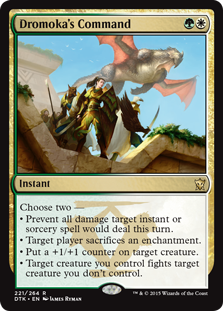 cards which shore up our ability to survive the metagame and fit perfectly into our strategy. Cleric doesn’t get buffed off Scales himself, but he gains a lot of life and rapidly puts us out of reach of many aggressive decks. He can also hear the song of the Battlesinger, so it’s not as if he can’t join combat at all. Command serves a similar function, giving us more interaction against cheap creatures and opening up many two-for-ones or even three-for-ones against the format’s premier aggressive decks (Burn/Affinity). The Scales and Command synergy is just gravy. Boros Charm is more aggressive and leads to some truly insane swings with Hardened Allies, but I think that’s too cool for a metagame with so much Twin, Burn, and Affinity. Command still gives us a small damage boost and insulates us from damage-based sweepers, adding in a layer of interaction which gives us legs in a diverse format.
cards which shore up our ability to survive the metagame and fit perfectly into our strategy. Cleric doesn’t get buffed off Scales himself, but he gains a lot of life and rapidly puts us out of reach of many aggressive decks. He can also hear the song of the Battlesinger, so it’s not as if he can’t join combat at all. Command serves a similar function, giving us more interaction against cheap creatures and opening up many two-for-ones or even three-for-ones against the format’s premier aggressive decks (Burn/Affinity). The Scales and Command synergy is just gravy. Boros Charm is more aggressive and leads to some truly insane swings with Hardened Allies, but I think that’s too cool for a metagame with so much Twin, Burn, and Affinity. Command still gives us a small damage boost and insulates us from damage-based sweepers, adding in a layer of interaction which gives us legs in a diverse format.
With that in mind, here is my take on the Allies list:
Company Allies, by Sheridan Lardner
Changelings are a tribal player’s best friend, especially Mirror Entity combined with our Druid mana generation. It's important to remember that Entity's ability only modifies base 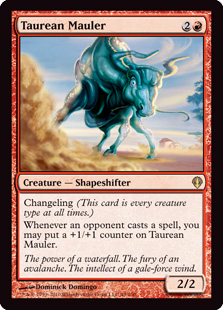 power and toughness, so any +1/+1 stack on top of this change, giving an extra boost to their damage output. I'm also a huge fan of Mauler here because an active Scales makes it pass the Bolt test, and then it's just one more spell away from outpacing Tasigur, Angler, and Goyf. I trimmed down the Company count to three and added an extra land to account for the loss of Vial. You could probably swap the Company triplet out entirely and put Vial in their place, removing that 21st land as well, which would synergize better with the lower creature count we have to run to accommodate Paths and Commands. Although I like Vial, the artifact makes us more vulnerable to Kolaghan's Command, and doesn’t lead to the big Company flips with an active Scales. I also appreciate the burstiness of Boros Charm and am sad to lose it, but we still get a mini damage pump in Dromoka's Command and benefit from the interactivity.
power and toughness, so any +1/+1 stack on top of this change, giving an extra boost to their damage output. I'm also a huge fan of Mauler here because an active Scales makes it pass the Bolt test, and then it's just one more spell away from outpacing Tasigur, Angler, and Goyf. I trimmed down the Company count to three and added an extra land to account for the loss of Vial. You could probably swap the Company triplet out entirely and put Vial in their place, removing that 21st land as well, which would synergize better with the lower creature count we have to run to accommodate Paths and Commands. Although I like Vial, the artifact makes us more vulnerable to Kolaghan's Command, and doesn’t lead to the big Company flips with an active Scales. I also appreciate the burstiness of Boros Charm and am sad to lose it, but we still get a mini damage pump in Dromoka's Command and benefit from the interactivity.
What do you all think of tribal Allies? How else have you built the deck and where would you take it from here? Let me know and post some lists: I’ll be sure to get back to you in the comment section!


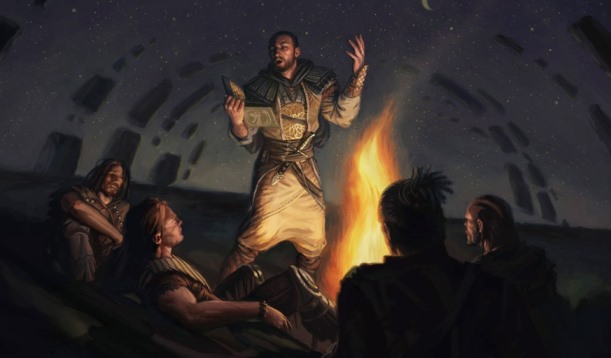


Isn’t this article reposted?
It was up last week for about an hour, and then it died when we were making some serverside changes. So it’s technically reposted, but it hadn’t been alive for very long to begin with.
No love for the Rally lists that combo off with the milling guy? Lost to one of these in the final of a win-a-box, I scratched my head for about two hours after.
That’s a really fun strategy. I’d love to do a followup on that more combo-oriented approach.
I actually joked with Sheridan that I wanted to toss a bonus decklist in for my “R-Ally Reanimator” list; it’s my deck of choice in the casual room on MTGO. I’ve noticed a huge uptick in wins now that Rally is in the deck (I originally wrote about the deck in my first Modern article back in 2013). I could see streamlining the deck into a fun FNM sweeper.
Since I’m certain my version is nowhere near optimal, maybe Sheridan will let me do a fun Saturday piece where I write about the deck and everybody suggest improvements?
Mind posting your list?
Sure. Again, far from optimal, but I seem to hit T4-5 wins often.
4 Kazandu Blademaster
3 Ondu Cleric
4 Halimar Excavator
4 Akoum Battlesinger
4 Hedron Crab
1 Angel of Glory’s Rise
1 Unburial Rites
3 Rally the Ancestors
4 Faithless Looting
4 Thought Scour
3 Izzet Charm
1 Gifts Ungiven
1 Noxious Revival
4 Scalding Tarn
4 Flooded Strand
1 Arid Mesa
2 Steam Vents
1 Godless Shrine
1 Watery Grave
1 Sacred Foundry
3 Hallowed Fountain
1 Plains
2 Island
2 Seachrome Coast
1 Desolate Lighthouse
The main win cons are the milling or swing for a lot of damage with Battlesinger haste/boosts. Usually you gain 10-50 life too. It might finally be time for the Angel/Rites package to go, but there are times where I cast Rally at their EoT, mill myself a decent chunk of cards, then untap and Rites on Angel for an even bigger reanimation burst that gets to stay in play (although it can’t get any Ondu this way).
It’s amazing how quickly you can sift through cards with Looting/Scour/Charm. Crab + fetches fill your own yard at turbo speeds and Halimar’s little self mills help too. I haven’t changed the land base since I replaced Immortal Servitude with Rally, so it could use some adjustments as well.
Not sure if this shell is close to what Jordan faced, but it is surprisingly consistent.
I like this article. I made a brew based off this but shelving the red, (if you’re not going to run Bolt, Akoum Battlesinger and Taurean Mauler aren’t enough to justify splashing another color IMO), and it’s tested very well. I think that the synergy between Mirror Entity, Collected Company, and Harabaz Druid needs to be played up more – the Druid may be a bit fragile, but T1 Freeblade into T2 Druid into T3 Company takes control of a game.
Yeah, that’s a nice synergy. Could be a great way to play up the burstiness, just like how Abzan Company can win off random flips with their own combo. It’s too bad Battlesinger doesn’t give Allies haste, or the win condition would be much, much scarier. Maybe BFZ will give us some new toys in that regard!
Hopefully. I think this tribe is pretty close to being a contender for Tier 2 – just needs a couple more tricks in the toolbox.
(MadKat here, the guy who made the original version) When first brewing the deck I felt the same way, and left red out. I happened to put it back in again and found out how powerful singer is…as in, there are times that you will get a turn 3 win with your battlesinger out! Aside from that, I’ve won many, many matches with battlesinger. What is your list looking like now? This is my current list…. http://tappedout.net/mtg-decks/all-in-allies/
I also agree on the red not being necessary. Seems like this deck wants Champion of the Parish. Sure, he won’t trigger allies, but he gives turn 1 redundancy since everything else will trigger him still.
I’ve seen parish in builds, I just don’t like the drop in synnergy, but I havent tested it. I brewed the initial deck list, and found me winning tons of times with singer, esp having the copycat ally. If you want, you can check out MODO dailies list; i 3-1ed 2-3 times and 4-0ed with the battlesingers.
Here is my current list: http://tappedout.net/mtg-decks/all-in-allies/
I threw together the tweaked build and it really is fun and explosive. Hardened scales makes every dude a threat. When you consider that most of this deck can be bought for under $15 with lands costing the most, it’s a bargain basher. Great find and great article. Normally I play zoo sans goyfs and hierarch, too spendy. This is a fantastic option for people with more limited resources.
I saw some Allies decks running around at some local tournaments where one of its pilots was mono W due to budget. All of those guys said something simple: Give us another good (or 2) Allies and the deck is Tier 2.
Kazandu Blademaster is the biggest reason, why this deck can compete. He easily outgrows Goyf and co and has with First Strike and Vigilance 2 very relevant combat abilities. Furthermore, Kabira Evangel is another big reason, why this deck works. Being able to swing through a stalled board “without” a problem is huge.
As you stated, CoCo is absurd in this deck. A single CoCo swings around the whole match, the second wins you the game (normally). It is nearly the same as with CoCo Slivers, the value you gain from CoCo is so huge, that many decks can’t compete with it. Since Sweepers are at a all time low, it might be wise to play such a deck.
Greetings,
Kathal
Hey, I just came across this article, would you mind citing me? My 5 color allies has been written about on multiple sites, such as tcgplayer, and pure mtgo.com. I’ve also placed a number of times in in the MODO dailies, with it being posted. My 5 color allies was the first successful use of allies, and I was the first to use it successfully with hardened scales. My username is MadKat. Thx!
wow, i totally looked over your reference…. My bad, I feel silly about that. sorry 🙁
No worries! I think citation and attribution is one of the most important and under-appreciated parts of Magic writing, so I’ll always cite finishes if I have the information. Also, if you have any interest in doing a contributor article about Allies and your experience with the deck, feel free to email me.
Yeah I would love to. Let me look through everyones comments, then I’ll hit you up. 🙂
So, I read through your article (I shoulda done that in the first place), and agree it is really hard to evaluate rogue decks, and to a lesser degree if you are playing the rogue decks.
I really like your article; you do a really good job articulating the strengths of Allies. Man, I consider myself a semi-pro brewer, but it is a completely different skill to turn around and write an article about it. I’m glad us brewers have someone like you who can flush out our brews. I have plenty more in the works, maybe we can do some brewing together sometime, and break the format…
I like your point on learning the lessons from previously established decks, and not necessarily copying it. I actually made the original version of all-in-allies based on merfolk and boggles. Merfolk with the amount of creatures, aethervial, and the land count. Also paying attention to CMC and what can be put in. (it was actually the master of the waves that convinced me to start trying Collective company) Boggles, I based it on because hardened scales allies is a lot like a combo deck, and you need a certain number of to make that combo. When making the deck, that is why i decided to include bojuka brigand and the blue allies, for the redundancy.
I like your point on dropping the vial, though I’m not sure if i want to yet. I do have trouble around that curve at times, but then other times vial totally wins the games. Also, I think the lesson we learned from merfolk is that 20 land aggro, with above 1 cmc creatures, needs vial. Buuuuuut, I could be wrong…..
I like Dromokas command: basically everything you said, and honestly, the two colors we are wanting to be always there are white and green. I don’t like Boros because it is harder on the mana. I’m definitely going to try this card today. The only thing is that it is two cmc instead of one, so it is harder on our curve since there are so many 2 cmc creatures…
I think in your list you are going for more of the tempo feel of merfolk, which i think I designed the deck to be able to do. Have you played this list yet? How is it working?
Here is my current list: http://tappedout.net/mtg-decks/all-in-allies/
I havent tried out any of the points brought up by Sheridan, so I may do that soon, but feel free to recommend changes including those cards! helps me remember to try them.
Hi guys!
What do you think about my ally budget friendly deck? I am looking forward to feedback 🙂
http://tappedout.net/mtg-decks/27-05-15-allies-budget/
Hey, I posted some feedback for you on your tapped out account.
Will you do a upgrade version after BFZ release? I have been playing your Naya Allies, it has been doing okay-ish, but a lot of fun.My record is 8-10-2.
Why wait? Try my 5 color allies, it does great in the meta… http://tappedout.net/mtg-decks/all-in-allies/
We’ll definitely revisit the deck with BFZ out. Although BFZ didn’t offer that many new tricks, the new one-drop and Lantern Scout (plus Ally Encampment) are all cards to think about in an updated version.
No love for Ghostway or blink effects? they’re particularly effective with allies like Hagra Diabolist in Mardu Allies.
Although these effects can be nifty, they are generally too slow and inconsistent to build a deck around. It works in something like Death and Taxes, but you can’t rely on those effects in the faster Allies deck. That said, I’m a huge fan of Flickerwisp in this format and think it could definitely have a home in Allies if they were lacking for interaction pieces. Ghostway, however, would be bad in tandem with Company/Vial/Chord.